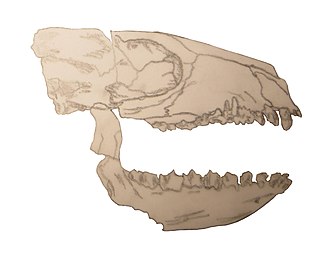Classification
The genus Asmithwoodwardia was first described in 1901 by Florentino Ameghino, based on fossilized remains found in Patagonia in terrains dated from the Late Eocene. The type species, Asmithwoodwardia subtrigona, is based on four molars. More complete remains, with similar but not identical molars, were found in the Itaboraí Formation of Brazil and were a few million years older than the type species, from the Late Paleocene ; the species A. scotti was established based on those remains.
Historically, Asmithwoodwardia was considered a South American member of a North American condylarth family, the Hyopsodontidae, and in particular related to the genus Hyopsodus. However, more recent discoveries of archaic South American ungulates and the attribution of a peculiarly shaped talus bone to Asmithwoodwardia indicates that this animal was a basal litoptern, a group of South American ungulates that thrived during the Cenozoic and occupied a variety of ecological niches. Asmithwoodwardia may have been a member of the possibly paraphyletic family Protolitopternidae, which included the most basal litopterns.

Litopterna is an extinct order of fossil hoofed mammals from the Cenozoic era. The order is one of the five great orders of South American ungulates that were endemic to the continent, until the Great American Biotic Interchange brought new ungulate species. Like other endemic South American mammals, their relationship to other mammal groups had long been unclear, but recent genetic and proteomic evidence indicates that their closest living relatives are Perissodactyls including horses, rhinoceros, and tapirs, and that litopterns are closely related to notoungulates, another widespread group of South American ungulates.
Condylarthra is an informal group – previously considered an order – of extinct placental mammals, known primarily from the Paleocene and Eocene epochs. They are considered early, primitive ungulates. It is now largely considered to be a wastebasket taxon, having served as a dumping ground for classifying ungulates which had not been clearly established as part of either Perissodactyla or Cetartiodactyla, being composed thus of several unrelated lineages.

Xenungulata is an order of extinct and primitive South American hoofed mammals that lived from the Late Paleocene to Early Eocene. Fossils of the order are known from deposits in Brazil, Argentina, Peru, and Colombia. The best known member of this enigmatic order is the genus Carodnia, a tapir-like and -sized animal with a gait similar to living African elephants.

Carodnia is an extinct genus of South American ungulate known from the Early Eocene of Brazil, Argentina, and Peru. Carodnia is placed in the order Xenungulata together with Etayoa and Notoetayoa.
Megadolodus is an extinct genus of Proterotheriidae, an extinct family of ungulates native from South America (Meridiungulates), belonging to the order Litopterna.

Prosotherium is an extinct genus of Typotheres, a lineage of mammal belonging to the order Notoungulata. It lived during the Late Oligocene, and its fossilized remains were found in South America.
Ernestokokenia is an extinct genus of mammal, belonging to the Didolodontidae. It lived during the Early Eocene and the Middle Eocene, and its fossils were discovered in South America.
Lamegoia is an extinct genus of mammals, belonging to the family Didolodontidae. It lived during the Late Paleocene in what is now South America.
Paulogervaisia is an extinct genus of mammal, belonging to the family Didolodontidae. Its fossilized remains have been found in South America.
Sparnotheriodontidae is an enigmatic extinct family of litopterns known primarily from teeth. Sparnotheriodontids are one of two South American native ungulate clades known to have reached Antarctica, the other being astrapotheres.
Carolozittelia is an extinct genus of mammals, belonging to the order Pyrotheria. It lived during the Early Eocene, and its fossilized remains were found in South America.
Propyrotherium is an extinct genus of mammals, belonging to the order Pyrotheria. It lived during the Late Eocene, in what is now South America.
Tetragonostylops is an extinct genus of mammal, related to Astrapotheria. It lived during the Late Paleocene, and its fossils were discovered in South America.
Protolipterna is an extinct genus of mammal, belonging to the order Litopterna. It lived during the Late Paleocene and the Early Eocene, in what is now South America.
Polymorphis is an extinct genus of mammal, belonging to the order Litopterna. It lived during the Eocene in South America.
Proadiantus is an extinct genus of herbivorous mammal, belonging to the order Litopterna. It lived during the Late Oligocene, in what is today South America.

Adiantoides is an extinct genus of herbivorous mammal, belonging to the order Litopterna. It lived during the Middle to Late Eocene, in South America.
Notonychops is an extinct genus of mammal, belonging to the order Litopterna, that lived during the Middle to Late Paleocene in what is today South America.

Anisolambda is an extinct genus of litoptern ungulate, belonging to the family Proterotheriidae. It lived from the Late Paleocene to the Middle Eocene in what is today South America.
Proectocion is an extinct genus of herbivorous mammal, belonging to the order Litopterna. It lived during the Early Eocene, in what is now South America.
This page is based on this
Wikipedia article Text is available under the
CC BY-SA 4.0 license; additional terms may apply.
Images, videos and audio are available under their respective licenses.













